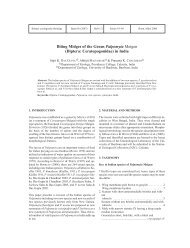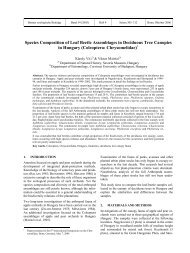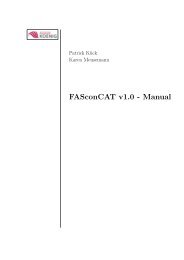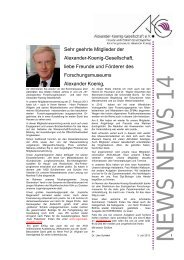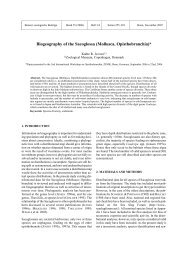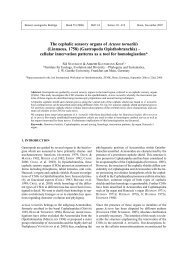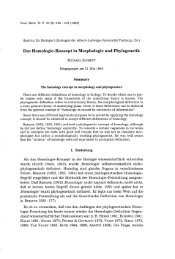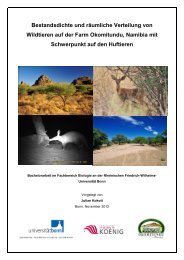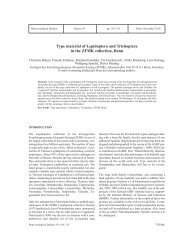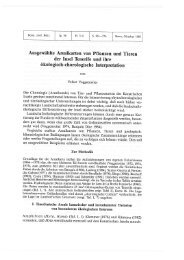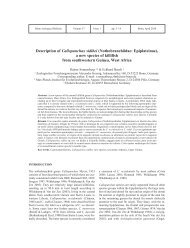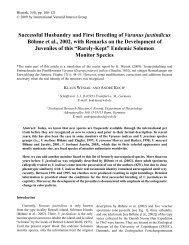Islands Between the Realms: A Revised Checklist of the ...
Islands Between the Realms: A Revised Checklist of the ...
Islands Between the Realms: A Revised Checklist of the ...
Create successful ePaper yourself
Turn your PDF publications into a flip-book with our unique Google optimized e-Paper software.
126 André KOCH et al.: A <strong>Revised</strong> <strong>Checklist</strong> <strong>of</strong> <strong>the</strong> Herpet<strong>of</strong>auna <strong>of</strong> <strong>the</strong> Talaud Archipelago, Indonesia<br />
lands and <strong>the</strong> Philippines and Halmahera, and only one<br />
species, Eutropis cf. rudis, in common with <strong>the</strong> Philippines<br />
and Sulawesi. However, some widespread non-invasive<br />
species like Cerberus rynchops, Python reticulatus,<br />
Bronchocela cristatella, Emoia atrocostata, E. caeruleocauda,<br />
Eutropis multifasciata, and Lamprolepis smaragdina<br />
are found at all four localities. It seems plausible that<br />
such widespread species were exchanged between <strong>the</strong><br />
Philippines and <strong>the</strong> Moluccas by using Sulawesi as a<br />
stopover ra<strong>the</strong>r than <strong>the</strong> Talaud <strong>Islands</strong> (but see below).<br />
Hence, <strong>the</strong> Philippines may have been colonized via <strong>the</strong><br />
Sangihe Island chain or arrived at <strong>the</strong> Moluccas via <strong>the</strong><br />
Banggai-Sula <strong>Islands</strong> finally reaching <strong>the</strong> Talaud Archipelago<br />
in <strong>the</strong> north. Never<strong>the</strong>less, it remains doubtful<br />
whe<strong>the</strong>r <strong>the</strong> Talaud <strong>Islands</strong> served as natural stepping<br />
stones (particularly during periods <strong>of</strong> lowered Pleistocene<br />
sea levels) on <strong>the</strong> dispersal route between <strong>the</strong> Philippines<br />
and North Sulawesi. INGER (1954) argued that <strong>the</strong> present<br />
distribution <strong>of</strong> <strong>the</strong> genus Oreophryne Boettger, 1895,<br />
which also occurs on Sulawesi and some islands <strong>of</strong> <strong>the</strong><br />
Lesser Sundas may account in favor <strong>of</strong> <strong>the</strong> Moluccan-Talaud<br />
corridor. Oreophryne, however, was never recorded<br />
from <strong>the</strong> Talaud <strong>Islands</strong>. The same applies to <strong>the</strong> genus<br />
Cornufer Tschudi, 1838 (currently a synonym <strong>of</strong> Platymantis<br />
Gün<strong>the</strong>r, 1858), which ranges from <strong>the</strong> Philippines<br />
through <strong>the</strong> Moluccas to New Guinea and <strong>the</strong> Solomons,<br />
but is not known from Sulawesi. According to INGER<br />
(1954), this taxon constitutes more evidence for <strong>the</strong> Talaud<br />
avenue between <strong>the</strong> Philippines and <strong>the</strong> Moluccas<br />
which also was later identified as major route <strong>of</strong> faunal<br />
dispersal by HOLLOWAY & JARDINE (1968). In ei<strong>the</strong>r case,<br />
<strong>the</strong> extinction or replacement <strong>of</strong> former Talaud populations<br />
by later invaders may explain <strong>the</strong>ir absence from <strong>the</strong> island<br />
group. As noted by WHITTEN et al. (1987) biological<br />
evidence for a stepping stone hypo<strong>the</strong>sis between <strong>the</strong><br />
Philippines and <strong>the</strong> Moluccas via Talaud is still insubstantial.<br />
Only fur<strong>the</strong>r field work and detailed morphological<br />
comparisons <strong>of</strong> sufficient material toge<strong>the</strong>r with molecular<br />
investigations including individuals from all areas involved<br />
could trace <strong>the</strong> unique history for each single<br />
species and <strong>the</strong> region.<br />
Comparison with o<strong>the</strong>r organism groups<br />
Distribution patterns <strong>of</strong> some o<strong>the</strong>r organism groups vary<br />
from <strong>the</strong> herpetological results presented here. VANE-<br />
WRIGHT & DE JONG (2003) traditionally included <strong>the</strong> Talaud<br />
<strong>Islands</strong> as part <strong>of</strong> <strong>the</strong> Sulawesi region in <strong>the</strong>ir review<br />
<strong>of</strong> Sulawesi butterflies. They predicted that colonization<br />
from <strong>the</strong> Philippines into North Sulawesi happened via<br />
Sangihe and Talaud. Likewise, NATUS (2005) in her analysis<br />
<strong>of</strong> endemic centers <strong>of</strong> Indonesian vertebrates defined<br />
<strong>the</strong> Sulawesi region as <strong>the</strong> mainland <strong>of</strong> Sulawesi plus surrounding<br />
island groups like Sangihe and Talaud in <strong>the</strong><br />
north. Interestingly, our herpetological results contradict<br />
<strong>the</strong> findings in butterflies by VANE-WRIGHT & DE JONG<br />
(2003) who eventually concluded that <strong>the</strong> fauna <strong>of</strong> <strong>the</strong> Talaud<br />
Archipelago most probably “belongs” to <strong>the</strong> Mindanao<br />
fauna.<br />
With regard to mammals, <strong>the</strong> Talaud and Sangihe <strong>Islands</strong><br />
are home to an endemic marsupial, <strong>the</strong> Talaud bear cuscus<br />
(Ailurops ursinus melanotus). These populations represent<br />
<strong>the</strong> nor<strong>the</strong>rnmost subspecies <strong>of</strong> this Sulawesian phalanger<br />
(FEILER 1977; 1990). At <strong>the</strong> same time, A. ursinus<br />
is <strong>the</strong> only example <strong>of</strong> a non-volant and non-invasive<br />
mammal that inhabits both neighboring archipelagos (RI-<br />
LEY 2002). Human translocation could be responsible for<br />
<strong>the</strong> exceptional distribution pattern <strong>of</strong> this species which<br />
is frequently hunted as food. On <strong>the</strong> o<strong>the</strong>r hand, both island<br />
groups harbor <strong>the</strong>ir own endemics, e.g., Tarsius sangirensis<br />
on Sangihe and Melomys caurinus on Talaud (RI-<br />
LEY 2002), which have <strong>the</strong>ir respective closest relatives<br />
on North Sulawesi and <strong>the</strong> nor<strong>the</strong>rn Moluccas (FLANNERY<br />
1995; MENZIES 1996; SHEKELLE 2003). There is ano<strong>the</strong>r<br />
population <strong>of</strong> T. sangirensis on <strong>the</strong> nearby Siau Island,<br />
which may warrant a separate taxonomic status (BRAN-<br />
DON-JONES et al. 2004). As a result, <strong>the</strong>se mammal taxa<br />
confirm <strong>the</strong> minor faunal similarity between Sangihe and<br />
Talaud, and at <strong>the</strong> same time, supply evidence for <strong>the</strong>ir<br />
close biogeographic relationships with Sulawesi and New<br />
Guinea, respectively.<br />
Consequently, <strong>the</strong> tradition to incorporate <strong>the</strong> Talaud Archipelago<br />
into <strong>the</strong> Sulawesi subregion within <strong>the</strong> transitional<br />
zone <strong>of</strong> Wallacea seems only conditionally justified<br />
from a herpet<strong>of</strong>aunistic point <strong>of</strong> view. Ra<strong>the</strong>r, this island<br />
group should be recognized as part <strong>of</strong> <strong>the</strong> nor<strong>the</strong>rn Moluccan<br />
subregion with closer zoogeographical links to<br />
Halmahera compared with Sulawesi or <strong>the</strong> Philippines.<br />
The transitional character <strong>of</strong> <strong>the</strong> herpet<strong>of</strong>auna <strong>of</strong> <strong>the</strong> Talaud<br />
<strong>Islands</strong> composed <strong>of</strong> both typical Oriental and Australopapuan<br />
faunal elements clearly reinforces <strong>the</strong> justification<br />
<strong>of</strong> <strong>the</strong> Wallacea region between Sou<strong>the</strong>ast Asian<br />
and Australopapuan biotas.<br />
Acknowledgements. We would like to thank <strong>the</strong> Indonesian Institute<br />
<strong>of</strong> Sciences (LIPI) for <strong>the</strong> permission<br />
(2767/SU.3/KS/2005) to conduct research in Indonesia. The kind<br />
support <strong>of</strong> Pak Dedy Darnaedy (Research Center for Biology,<br />
LIPI) Pak Mulyadi and Pak Irvan Sidik (both MZB) is acknowledged,<br />
too. Fur<strong>the</strong>r we are grateful to Ibu Mumpuni (MZB) for<br />
<strong>the</strong> permission to examine specimens under her care. In addition,<br />
we are greatly indebted to Pak Henry, teacher in Lirung<br />
(Salibabu Island), who substantially supported our field work as<br />
well as to Sahid Kampi (Tahuna, Sangihe Island) and his bro<strong>the</strong>r<br />
in Lirung (Salibabu Island) for logistic support. We thank<br />
Rainer Gün<strong>the</strong>r (Berlin, Germany), Jakob Hallermann (Hamburg,<br />
Germany), Maren Gaulke (Munich, Germany), and An-




